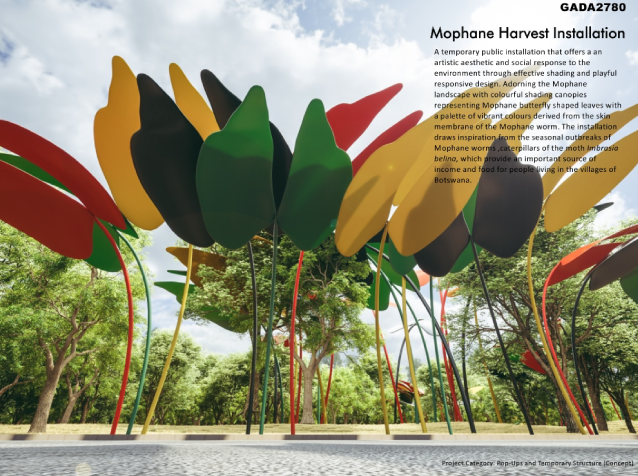
Fresh from winning two awards for her Old Palapye Museum Historic Building Preservation Design at the A’Design Award & Competition 2019 and the Architecture, Building and Structure Design Category (2018-2019), Motswana architect, Beullah Serema has released yet another award-winning architectural masterpiece.
Styled the Mophane Harvest Shade Installation, the concept bagged the first award under the category of Pop-Ups and Temporary Structure at the Global Design & Architecture Design Awards 2019. According to Serema, who works under the Atelier Noua Studio, the installation draws inspiration from the seasonal outbreaks of phane worms (Imbrasia Belina), a source of food and income for people in northern Botswana as well as city dwellers.
The idea was to build a series of colourful, temporary shade installations inspired by the form and shape of the Mophane tree leaf, shaped like a butterfly. The concept also implemented some vibrant colours of the Mophane worm.
During the phane season, harvesters from across various villages set up camp around the outbreak areas dotted along the A1 Highway that dissects eastern Botswana. The harvesters would are then able to sell their harvest to people travelling from Gaborone to Francistown and other places in the northern parts of the country.
“This has led to the transformation of the landscape and the environment where parts of the roadside are heavily articulated by floating umbrellas and makeshift shades for harvesting and mainly selling the products under the day sun,” reads Serema’s design concept.
Beyond its function as a shade installation, the Mophane harvest shade installation marks the beginning of a season that is highly embraced by local people as a source of food and income which should be celebrated in the form of a temporary structure. It can also be used by road users while travelling, as a spot at which to take a breather and maybe even grab a photo op. Additionally, it can be used annually to mark the beginning of the Mophane harvest by adorning the streetscape and areas with temporary colourful installations.
“The intention is to tell the story of the existing environment and its relationship with the people. The series of installations creates a free public space along the roadside for harvesters to freely sell their products under protected conditions from harsh weather,” Serema said.
The temporary installation will be used for the duration of the season of the phane worm to mark the bagging of the phane harvest. There are two seasons annually, each lasting about a month depending on the weather.

Serema has made provision for two types of shade installation, one which would be used by the road for selling the produce and one that would be used by the harvesters for the preparation and drying of the product, located a distance away from the road and within the treescape of the Mophane trees. The materials proposed for the installation involve recycled plastic components making the surface and structure for the whole installation.
Serema was awarded The Ministry of Education, Culture, Sports, Science and Technology (MEXT) Scholarship by the Japanese Government in 2017 to pursue her PhD in Architecture at Tohoku University, Japan and her designs are concepts that could positively impact Batswana if they were implemented.
Source: re-thinkingthefuture.com




I am trying to make contact with Beulah Serema’s, the architect that got an A award with her Old Palapye museum design.